#also he has like five million gun posters and what if the new guy wanted smth different what then
Text
So I'm wondering, did Pete have a roommate before Porsche? Sharing rooms seems to be a normal thing (room layout is clearly for multiple people), but Pete didn't have one when Porsche came. Was he just always alone (could explain the no-pants workout, since Pete is shy about it), or did his roommate like,,, die, and didn't get replaced until Porsche joined??
Quitting isn't a thing to the family, and the person never came back so it wasn't a vacation either. Did the minor family buy them maybe? Unless Pete just never had a roommate, which I find kinda sad but also congrats dude you got a suite to yourself that's pretty cool
#just random thoughts#you think pete was a lil cranky at first that hed have to give up space?#not spiteful or mean at all but more like oh what if the new roommate is a dick and now i cant do my butt workouts in the open anymore :(#also he has like five million gun posters and what if the new guy wanted smth different what then#i can see pete being protective over that#tho i can also see him as being easy and a bit of a pushover to avoid conflict#can be anything really#kinnporsche#kinnporsche the series#pete kp#pete phongsakorn#porsche kp#peteporsche
35 notes
·
View notes
Text
My Chemical Romance Was an Excellent Band and You're Not Special for Shitting on Them

There was a time when I was extraordinarily uncool. Around age 11 my fashion sense was a mess, my hair was messier, and I listened to My Chemical Romance. 2004. What a year. I was bullied for a lot of things, from my big belly and lil tiddies to my love for these pants. But most especially, I was bullied for my taste in music (no, I’m serious).
I have a distinct memory of a boy who (shall not be named) (thought Billy Talent was the best band ever) would stuff notes in my middle school locker telling me to kill myself because I was an “emo shithead” who listened to MCR. I remember one girl at sleep away camp (I’ll name her) (it was Serina) (she won’t read this) who had a lot to say about my “fat ass” and even more to say about my passion for music, which was dubbed “whiney screaming boy band garbage.” Good times.
I wrote an article last year about my trials and tribulations with what has been christened “mall emo” and I found out that not only was I accompanied in my laments, but there were literally thousands of people who went through similar things as pre-teens. The difference was, I was bullied into believing that My Chemical Romance was embarrassing. That there were not worthy of praise, and rather, they were something to be ashamed of. Don’t give anyone the idea that you like them. They will make fun of you. They will make you feel stupid. My secret of loving this band became a sinking feeling in my stomach. This feeling followed me through college and beyond.
The truth was, My Chemical Romance wasn’t just a good band. They were very good. So good that people, to this day, continue to run fan blogs about them despite the fact that they’ve been broken up for like, five (almost six) years. Fans are making their own merchandise. They’re starting podcasts. They’re starting bands. They’ve been following MCR since age 11 like me, or they’re discovering them now as high schoolers, and now, they’re reflecting on how groundbreaking, magnificent, and prolific this band was. It’s not simply teen angst driving them. These fans are older now. They’re looking beyond that and seeing My Chemical Romance for what they were: poetic, theatrical, sincere music.
From the beginning, they wanted to start a band that sounded like if “Morrissey had joined The Misfits” and they achieved that through their songwriting, expressive creative vision, and their dynamic performances whether they were playing to ten kids in a basement in Philly or a packed arena in Mexico City. There are a plethora of tracks in their discography that illustrate this, but “Thank You For The Venom” is perhaps the most obvious nod to Moz and Jersey’s horror punk band. Later in their career, they took on a bigger, brighter, arena-filling Queen-inspired sound with The Black Parade and broke down barrier after barrier in terms of career success. Later, they brought pop back into the mix on Danger Days and inspired so many with a beautiful apocalyptic concept which brought us the comic books. Conventional Weapons came around and we were faced with another realm of MCR — one that was dirtier, grittier, and yet still uniquely them.
The roses in the sink. The night vision photoshoots. The blood-drenched magazine covers. The intensity of their music videos. Their old website. The merch and the album booklets and the show posters and the backdrops. The band had every hand in what they visually stood for. It was impressive and almost insane how much work and attention and thought was put into how they were visually perceived. My Chemical Romance took on each new album like one would approach a cohesive feeling — each was its own separate art project with a distinct manifestation. They captured pain and suffering and also valor and heroism all in the same vein. They were stunning.
Gerard Way was an exceptional frontman from his effortless highs to his on-the-brink-of-death lows. Throughout the entirety of his career with MCR, he was acutely aware of himself and what he represented to millions of fans around the world. A powerful symbol of what it means to face adversity and to be unafraid to "keep on living." On the opposite side of the coin, he was an Iron Maiden and Morrissey fanboy with a deep love for Dungeons & Dragons. He loved his grandma. He wore his heart and every other internal organ on his sleeve. He fought against many things: misogyny, mental health stigma, homophobia, transphobia. Way stood for inclusion and acceptance against all odds, especially during a time when bands were still asking girls to show their tits on camera for backstage passes.
“You’re not in this alone” was the first MCR lyric ever written from the song “Skylines and Turnstiles." It became the main idea behind the band, as well as a mission statement for them to stand on if they ever lost sight of what was important to them. More importantly, My Chemical Romance never shied away from how enthusiastic their fanbase was (and still is). “Sometimes, honestly, I feel like we’re moderating a support group,” Gerard Way told Spin in 2007. “We tap into dark stuff from the high school years, and it’s our responsibility to bring kids to a positive, nonviolent solution.” They took responsibility for their actions, never faltering on their goals, and they always made kids feel less alone. “It's okay to be fucked up, 'cause there are five guys in this band who are just as fucked up as you but we've overcome that to do what we do,” Way said in Life On The Murder Scene.
When the music stopped and My Chemical Romance broke up, it was bitter-sweet (mostly bitter) (just kidding). In truth, there was a sigh of relief, but also sorrow. Where else was the band going to go? How much further could they take it? What can we expect from the Way brothers and Frank and Ray in terms of new musical projects that weren’t My Chemical Romance? One could argue that there were plenty of other “emo” bands who were doing something similar — writing intimate songs about intimate things. But admittedly, on a grand scale, no other band did it like MCR. They filled arenas and moved over five million albums over the course of their career which spanned a killer twelve years. They were an enormous band playing loud as fuck songs about incredibly personal ideas and they continued, without fail, to include every walk of life on their journey through the ups and the downs.
My Chemical Romance created a new musical frontier. Unassisted, they formed an entire subculture of teens and young adults — especially women, mentally ill teenagers, and LGBTQ+ people — who could network together and find acceptance and solidarity in their suffering, which continues to be stigmatizing and written off as the usual case of “teen angst.” Your problem? You’re lead to believe that just because a band has a majority female fanbase it’s not considered sincere and heartfelt music. That it is automatically cringe-worthy and unqualified to be critiqued the way good bands should be critiqued: based on the quality of their music, their artistic vision, and their ability to perform in an entertaining manner. My Chemical Romance was superb. Let go of your misogyny.
And that’s that on that.
Catherine Dempsey’s gun fires seven different shades of shit. So what’s your favorite color, punk? You can follow her on Instagram and Twitter.
Follow DRM on Facebook, Instagram, and Twitter.
#my chemical romance#my chem#mcr#mcrmy#gerard way#frank iero#mikey way#ray toro#alternative rock#emo#feature#catherine dempsey
2K notes
·
View notes
Text
Dragon Ball: Sleeping Princess in Devil’s Castle

Time for the second Dragon Ball Movie. SPDC premiered on July 18, 1987, right between Epsiodes 70 and 71 of Dragon Ball, so I’m gonna talk about it here.

The opening sequence is gorgeous, but you can tell right away it only looks like this to introduce the legend that starts the story. I sort of wish the whole movie would look this way, but I can understand why that wouldn’t be a great idea.
So the story goes that there was this beautiful princess, and she’s trapped in a place called Devil’s Castle.
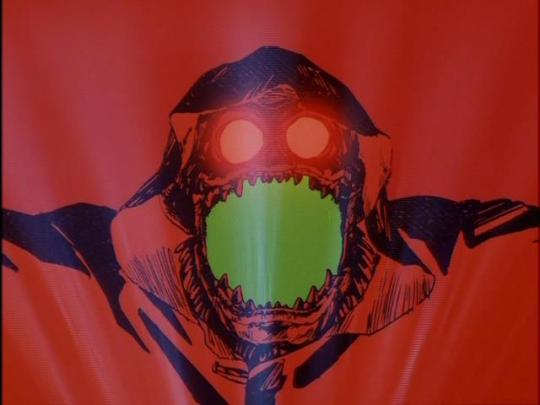
Oh, and here’s this guy. I guess he’s the devil.

And here’s the title card. Immediately after this is the same old opening theme we see in every episode of the TV show. I like these kinds of openings, where everything’s super ominous and it all looks really terrible, and then the opening credits roll and heyyyyyyy, here’s Goku, and he can fix it. He’s gonna bop that devil on the schnozz.

So the first seven minutes of this movie are just directly lifted from the episode where Goku goes to Master Roshi for training, and Krillin arrives soon after. The only real difference is that Goku doesn’t bring back a bunch of strange women. Krillin shows up almost immediately after Goku, and he does all the same stuff he did in the anime. To be fair, Toei at least didn’t stoop to recycling the original footage, but it’s pretty dull watching a rerun, no matter how you slice it.

Yeah, he’s watching aerobics, just before, only now the girls are doing butt stuff instead of leg stuff.
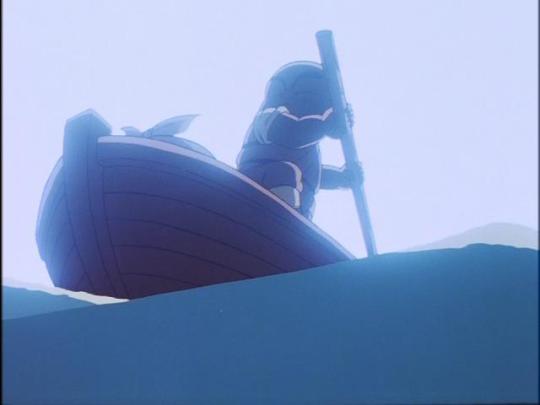
And Krillin’s riding a boat, just like last time, only now he’s in shadow, like this is some big mystery or something. KIDS, DON’T REVEAL THE SECRET TWIST THAT KRILLIN IS IN THIS MOVIE.

Roshi insists that the boys have to bring him a cute girl before he’ll show them anything, but in this version, he doesn’t bother waiting for them to figure out what he wants. Instead, he demands a specific girl, the Sleeping Princess in Devil’s Castle. He then pulls out a map, not too dissimilar to the one he used in episode 69 to point out Fortuneteller Baba’s home. Roshi explains that the princess was captured by a lecherous demon a long time ago, and she’s apparently super beautiful. No one ever addresses the fact that she’d be much, much older after all this time, but Roshi’s over 300 years old so maybe that’s why it never comes up. Anywho, first kid to bring her back to the island becomes Roshi’s pupil. Second prize is a set of steak knives. No, just kidding, second prize is nothing.

Meanwhile, someone else is researching the Sleeping Princess legend, and decides she wants a piece of that action. Is Launch looking for a pichi-pichi girl too? No, she’s seen this movie before, and knows what this is all about.

Roshi tells the boys that the castle is far to the west of here. Every damn thing in this anime is to the west. Bulma went west looking for the Dragon Balls when she found Goku, and then they went further west to find the rest of them. But Bulma lives in West City, so Goku had to go west to find it. Is there nothing to the east? I know this planet is a sphere, and if you go far enough west you’ll get where you’re going, but still.

Anyway, Krillin is a little shit for most of this movie, as he treats the competition very seriously and does whatever he can to sabotage Goku so he can get an inside track.

Also, he rides the bus part of the way, which is kind of crappy since Roshi told Goku he couldn’t use Kinto’Un. Well, it’s only cheating if you get caught, or at least that’s what all those heel wrestlers say.

Bulma and Yamcha drop by to visit Goku, and Roshi doesn’t want to tell them he sent him on an errand to Devil’s castle, so he makes up some thing about an amusement park. They decide to follow Goku, and I guess Roshi told them exactly where Devil’s Castle is, because they managed to find it easily enough.

Near the end of the journey, Goku gives Krillin a helping hand, because he’s such a swell guy. Keep that in mind.

And here’s the Devil’s Hand, a range of five mountains that surrounds Devil’s Castle.

The boys head inside, and the whole place looks like an H.R. Giger painting. Get used to it, because the rest of the movie looks exactly like this.

Bulma and Yamcha get captured by monsters shortly after the sun goes down, and Bulma wakes up in a pretty fancy bedroom.

The master of the estate greets her and introduces himself as Lucifer. Yes, nothing suspicious going on here.

Bulma is smitten, but only for a moment before she asks what happened to Yamcha, Puar, and Oolong. Lucifer doesn’t answer, and invites her to dinner instead (as the main course ha ha ha).
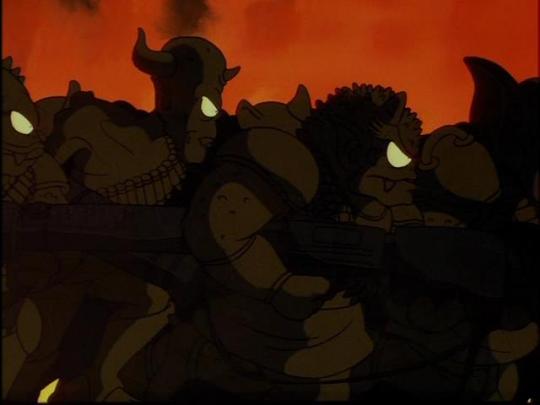
Down... stairs? I have no idea how this castle is supposed to be laid out. There’s a different area where Goku and Krillin are, and they get trampled by a horde of monster carrying machine guns.

Also this little pink thing is with them. He’ll be important later.

Their leader is... this guy. He never identifies himself, even though Goku and Krillin ask who he is. His name’s Ghastel, for what it’s worth, but he really doesn’t matter. He fights with Goku a little bit, and while Goku’s busy with that, Krillin tries to sneak away to search for the Princess.

Lucifer’s “dining hall” looks more like a big tower with rows of monsters standing around. There’s this big four-poster bed which supposedly contains the Sleeping Princess, but he announces Bulma as the guest of honor, and has her seated on a throne.

Then he turns into a monstrous form as he explains that they’ll be using Bulma’s blood to toast the reawakening of the Princess. So were they just waiting for a girl to show up before they would go through with their plans, or did Bulma just pick the wrong night to show up?

By the way, Yamcha, Oolong, and Puar are running around in this place, too. So did the bad guys take Bulma and leave the others alive? You’d think they would have killed and eaten them by now.
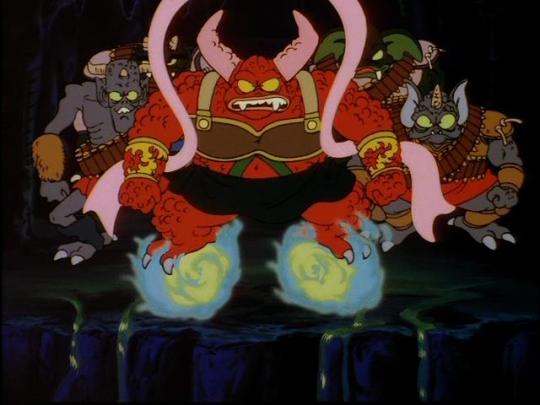
Back to Goku, he ends up rescuing Krillin when he gets in over his head, but Krillin insists that he owes Goku nothing for that. Ghastel has some sort of flying fireballs that he can ride on, so he has a mid-air battle with Goku on Kinto’Un, but then Ghastel gets eaten by a monster, so that takes care of him.

All right, so Lucifer explains to his followers that the full moon will reawaken the Sleeping Princess, and I guess they don’t need Bulma’s blood to pull that off, it’s just kind of nice to have some blood to drink on this auspicious occasion.
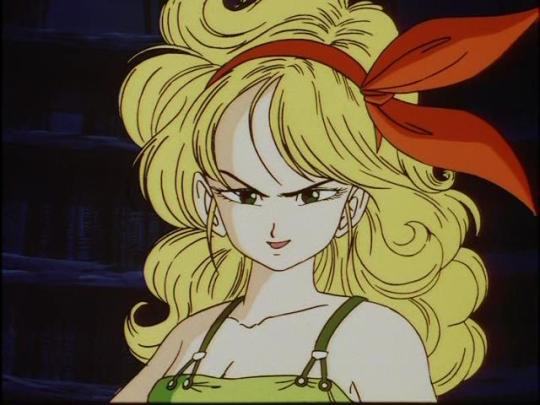
But suddenly--Launch! She shows up and takes the Sleeping Princess from the bed before Lucifer knows what’s happening.

Yeah, turns out the Sleeping Princess was a giant diamond the whole time. I guess the legend about a girl being captured by a lecher was based on Lucifer’s custom of grabbing girls like Bulma, which got conflated with the diamond he probably stole at some point.
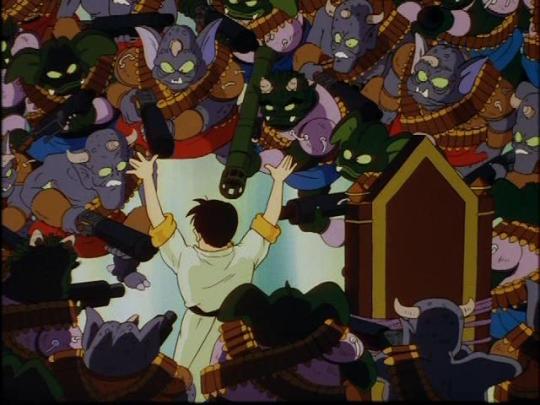
While this is going on, Yamcha tries to free Bulma, but Oolong’s disguise fails, and then Paur exposes his own disguise when he notices this. So now Yamcha’s captured. Also Launch gets captured when she sneezes at an inopportune moment.
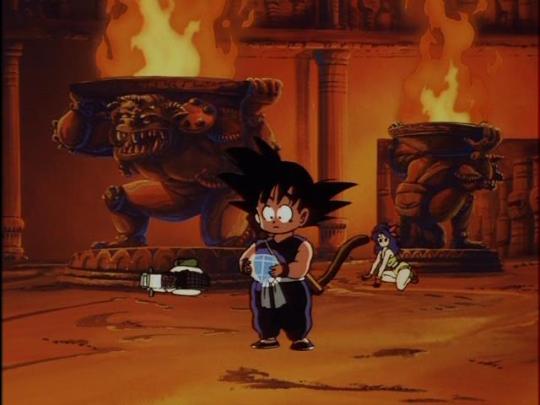
Goku gets the gem for a hot minute, but then Lucifer grabs Krillin and demands that Goku surrender the Princess for Krillin’s life.

And Goku agrees, much to Krillin’s amazement. But Lucifer sics all his goons on Goku anyway, and that little pink feller bites Goku’s tail, so now they’re all captured.
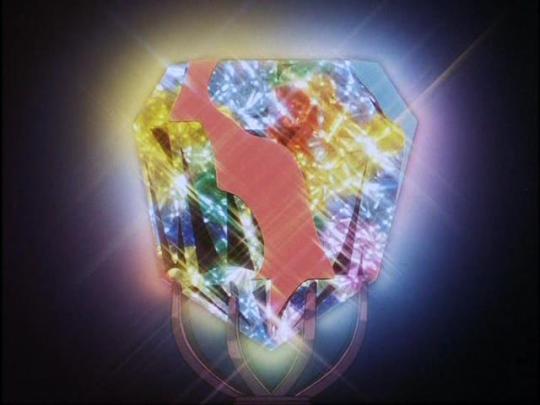
Somehow, the light of the full moon gets focued through the castle and into the Sleeping Princess, which makes it all glowy and stuff.

While this is going on, the gang is held captive in a block of solid granite? How did they put this thing together? I think the animators just didn’t feel like drawing anyone’s body that day.

Anyway, Goku notices the full moon and uh-oh.

The good news is that Goku’s sudden expansion frees the whole gang, but the bad news is that Goku chases after them and nearly eats Launch.
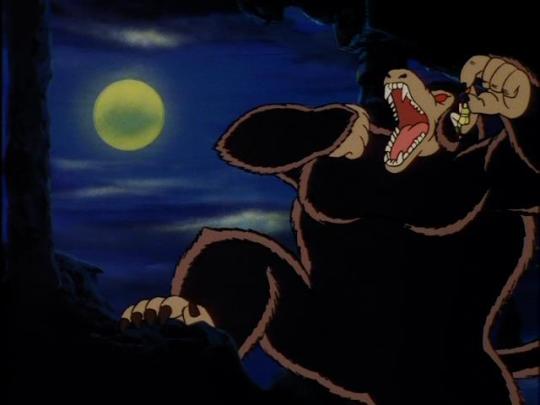
Where is Bulma and Lucifer while all of this is going on? I thought he was going to drink Bulma’s blood before this whole thing started, and now he’s taking his sweet time about it.
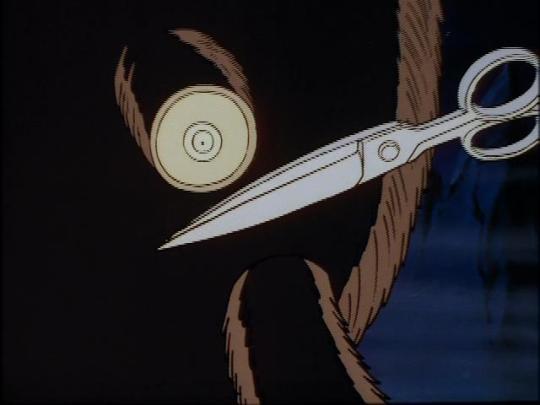
Yamcha and Krillin grab Goku’s tail, Puar turns into scissors and yeah, we’ve seen this before. Goku wakes up nude, wonders what happened, and then he borrows Oolong’s pants.
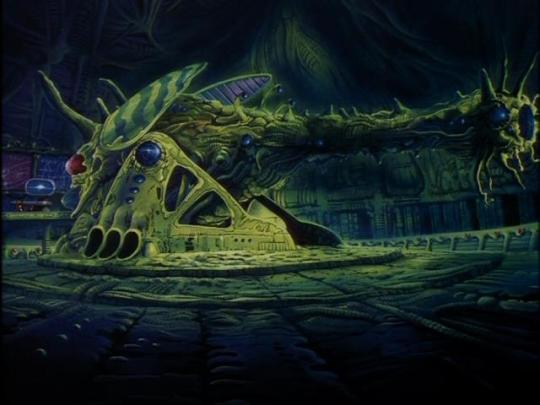
Back to the original part of the movie, this here is Lucifer’s Devil Castle Cannon, which is why he needed the Sleeping Princess to be reenergized. Come the dawn, he’s gonna power this bad boy up and shoot it at the sun, which will supposedly destroy it.

See? He’s got charts and everything to help him line up his shot. I still don’t understand why he’s only just now getting around to this. He’s had the Sleeping Princess for so long that it’s become a legend. There’s a full moon once every 28 days. Does he really need a chart to tell him where the sun will be?
I almost wonder if the cannon doesn’t even work. He’s telling Bulma all this, but we never find out if he can pull it off (spoilers, Goku stops him from blowing up the sun). Maybe he does this whole routine every month, and he’s been doing it so long that he’s too insane to consider that it never works. Maybe he thinks he has to shoot the sun a million times to whittle it down.

Anyway, the gang arrives to save Bulma and save the day, and Goku and Krillin are finally working together, because Krillin realizes that Goku’s a good dude. You know what that is? Growth.

Goku can’t beat up Lucifer, though, so Bulma tells him to take out the cannon. He fires a Kamehameha at it, but this only seems to destroy whatever it’s sitting on. As it tips over, it fires, hitting Lucifer instead of the sun, and that’s the end of that guy.

So the sun rises like it always does. Look at that smug bastard. You’ve won this round, sun, but the war goes on...
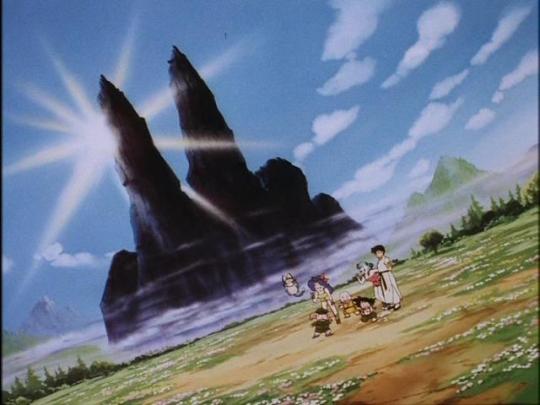
Then the gang takes a selfie in front of the Devil’s Hand, which now looks like a peace sign because I guess three of the mountains got broken up during the battle.

Back at Kame House, the boys explain that they failed, but Roshi is so pleased with Launch that he doesn’t care, and he agrees to take on both of them as his disciples, so everyone wins!
I guess this movie’s all right, but it suffers from a lot of the same problems that plagued Curse of the Blood Rubies. Way too much time is devoted to slavishly recreating moments from the original story, and I’m pretty sure anyone watching this movie would have already seen the original story by now. I don’t think there’s a lot of fans who set out to watch the movies first.
To me, the real hook of this film is Lucifer, since he’s the big new idea being presented here, except he’s not really that innovative, since he’s a vampire. A jewel being used to power a super weapon isn’t particularly novel either. The coolest idea is that he’s willing and able to destroy the sun, but there’s not really a good way to pay that off. He can’t exactly succeed, and if he fails, then he’s just a crackpot with a big gun.
I like the idea of Blonde Launch as this devil-may-care bandit who would dare to steal a treasure like the Sleeping Princess from a literal horde of monsters, but that’s not what this movie was about. They just shoehorned Launch into the story so she could satisfy Roshi’s demand for a cute girl once the Sleeping Princess was lost. Why not let the characters breathe a little? We don’t need to see Launch play out the same role she’s already played out on the TV show. You can do other things with her.
It is a pretty fun adventure. There’s plenty of scenes of Goku and Krilin fighting monsters, and it’s kind of scary without being actually scary. Lucifer’s henchman has a giant syringe to draw Bulma’s blood, for example. It’s worth a watch, but as far as essential parts of the Dragon Ball franchise, this is definitely optional.
#dragon ball#sleeping princess in devil's castle#2019dbliveblog#goku#krillin#lucifer#master roshi#bulma#launch#yamcha#oolong#puar#ghastel#dbmovieliveblog
18 notes
·
View notes
Photo
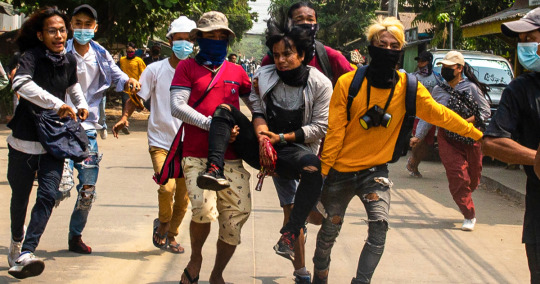
Myanmar: Five protesters explain why they will not give up
Myanmar: Five protesters explain why they will not give up
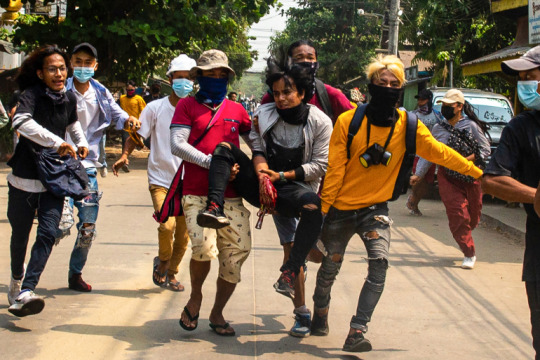
Hundreds of people have been killed in Myanmar amid an increasingly violent response to continuing protests calling on the military to step down and restore democracy.
The Assistance Association for Political Prisoners, an advocacy group tracking deaths and detentions, says 510 people have been killed in the violence with Saturday marking the bloodiest day since the military seized power in a coup on February 1.
Analysts doubt the brutality of the crackdown by the military, also known as the Tatmadaw, will deter the protesters.
“Incredibly, although the Civil Disobedience Movement (CDM) comprises unarmed protesters with their flimsy homemade tin shields and hats, they have been able to deny the ‘mighty’ Tatmadaw the things they most crave: control over the country and economic stability,” said Gwen Robinson, a senior fellow at Chulalongkorn University’s Institute of Security and International Studies in Bangkok, and editor-at-large at the Nikkei Asian Review.
“By sheer force of their spirit and bravery they have foiled the generals, and to me that is a significant victory.”
Myanmar has a population of 54 million with about a third from ethnic minorities.
The military has begun bombing in eastern Karen state, which has sent thousands fleeing into neighbouring Thailand. On Tuesday, three ethnic armed groups including Rakhine State’s Arakan Army released a statement demanding the military stop the killings of civilians.
Robinson believes the coup has helped unite the country against the military.
“You have got big business, civil society, ethnic groups, different religious people all against the coup – that is an extraordinary thing,” she said.
With Robinson warning that Myanmar could end up a failed state with a brutal dictatorship holding onto power through sheer force, Al Jazeera spoke to five protesters about why they have taken to the streets and what might happen next.
The front-line protester

20-year-old ‘Fox’ has been on the front line of the protests and is currently in hiding
“Fox” said he and his group demonstrated peacefully until the military started killing their friends: “That’s when we decided we would fight back”. The 20-year-old is part of a group of front-line protesters, with the youngest only at 15.
“I’m making all the decisions, it’s a lot of responsibility, especially when I have these kids, but they’re good kids, we’re a good team and doing good so far.”
The group has experienced a lot in the last few weeks of protest and was forced to run for their lives from military bullets, after soldiers shot directly at them.
One of Fox’s roles was to help build sandbag barricades but the security forces used brutal tactics to get rid of them.
“They took hostages,” he said. “They pointed guns at people who are walking around these defence lines and took them hostage. And because they have these hostages, people in the neighbourhood don’t attack the military any more because they don’t want to harm innocent people.”
Now the group is in hiding – after a fellow protester was arrested and his phone seized. Fox and his group’s names were in it, along with many others.
“They got his phone, and they tracked other front liners with the information they have from that, and that guy that got arrested died in custody. They killed him in custody, they tortured him.”
This is how Myanmar protestors bravely defend themselves with firework sticks, slingshots from inhumane terrorists with live ammunitions.
Location – Ahlone township
– Myanmar labour news#WhatsHappeningInMyanmar#Mar18Coup pic.twitter.com/3ohfmB4iBY
— pyaezone (@pyaezone) March 18, 2021
Al Jazeera was not able to independently verify the death, but Fox sees the protester’s murder as a warning from the military that, “this is what is going to happen to you if you keep doing this”.
Last week, as the military hunted the group, they escaped Yangon by bus. The vehicle was stopped by the police eight times during the trip to a safe house but none of the group was identified.
“Everyone is scared of being hurt or being killed, but at the same time it’s scarier to think about what the military would do if they win this, and that’s what the older generation don’t get at the moment,” he said.
“They keep saying: ‘No don’t go out now it’s dangerous’, but if we don’t go out now and fight for this, it’s going to be dangerous for the rest of our lives.”
The organiser

Thet is an online activist who has built up a network of safe houses to protect protesters who are being sought by the military
Thet says she supports the CDM with online activism, her popular Instagram account and spying on the military.
“I collect, condense and share information. I have a bike and I go scouting early in the morning to identify what the military’s movement patterns are and what townships will be hit hardest.”
Thet also assigned herself the task of keeping count of those killed by the military, known in Myanmar as Tatmadaw, and their personal details, but the rising toll has come at a cost.
“For me, the deaths blur together because the circumstances are the same. I feel quite empty, very hollow. I feel like there are bees in my head buzzing all the time. I don’t know what life was like before the buzzing started. Maybe it started when they killed those people way back in February in Mandalay.”
She says she has also been searching for protesters who have disappeared.
“Staff in local jails – at risk to their lives – sometimes pass on information about arrested protesters,” she told Al Jazeera.
The activist, who is in her 20s, says she has built a network of connections to find safe houses for protest leaders forced into hiding.
“The ones I have worked with have not been caught, and I hope it stays that way.”
Thet says she admires protesters’ creativity and the humour of the civil disobedience movement: “I have an immense love and respect for our citizens, there are some ways in which I think our country is full of loveable comedians who are trying to bring life into everything they are doing.
“We have a popular banner which is very Burmese: ‘We will win, maybe not immediately, but definitely we will win’.”
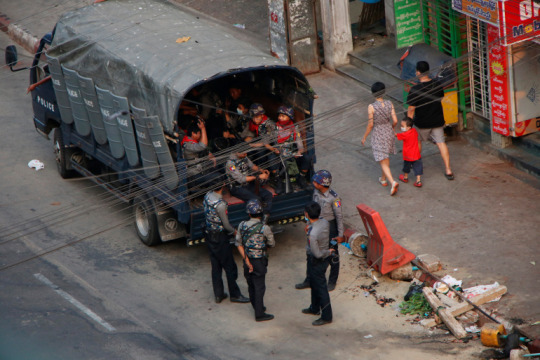
Thet goes out on her bike each morning to get a sense of what the security forces are doing. More than 500 people have been killed since the February 1 coup
Amid the escalating violence, protesters have been writing “death letters” to their family and the public to encourage people to continue resisting the generals, according to Thet.
Traditionally, mourners offer food to the Buddha and monks when someone dies so their spirit can be at peace but the anti-coup protesters want things done differently if they are killed.
“They write: ‘Don’t do that, even in death I will still be by your side until you win. Please do not donate food, I still want to stay and fight. I will not move on until we’ve won’.”
Thet also has written her own letter and told those she trusts where they can find it.
“A lot of my letter is a request to protect my body,” she said. “I want to donate my organs to someone who needs them, not for them to fall into the hands of the military who will just sell them for their selfish reasons.”
The pastor

U Man took part in the 1988 Uprising, which was brutally suppressed by the military. He says their tactics remain the same
U Man, a pastor leading a congregation in Yangon, says that as well as providing spiritual support to protesters he has driven them to demonstrations, given money to their families and raised funds to buy protective equipment such as gas masks and helmets.
As a teenager, U Man took part in the 1988 uprising, before the military crushed all dissent, leaving thousands of people dead.
The pastor, who is in his 50s, does not believe the military’s strategy has changed since then.
Both then and now, he says the military inserts a “dalan”, an infiltrator, into the crowd to provoke the Tatmadaw and set up a conflict.
He has advised his son, who has also joined the protests, and others, not to engage with the security forces and to identify the infiltrator through a simple three part instruction that he hopes will save lives: “Don’t engage with the military. Find out who the dalan is. Don’t let the dalan control the narrative.”
“Being a minister of the Christian faith, I don’t want to recommend anyone using violence,” he said. “I know people who have been beaten. It’s very difficult for me because I have all these feelings of anger and anguish, and if I had a weapon, I would use it against them. That makes me feel shame because I am a pastor,” he said.
U Man says he prays with his children and protesters before they go out into the streets.
“I teach protesters and my congregation about the Bible and those people in it who experienced challenges, the mindset they had to overcome them, and how God is able to save them,” he said.
The teacher
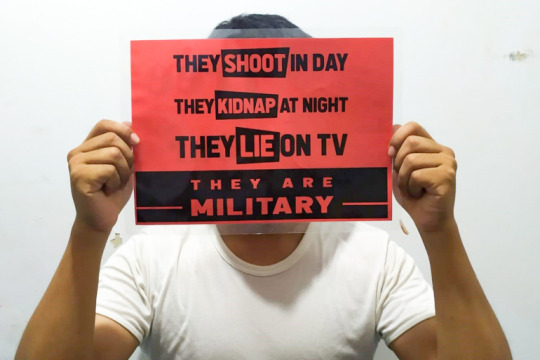
Teacher Aung Myo Zaw says he feels both scared and hopeful
“I have been tear-gassed. A lot of my friends were shot by rubber bullets,” Aung Myo Zaw told Al Jazeera.
The 32-year-old teacher says he is afraid of getting shot while protesting, but people were coming up with different tactics to keep the spirit of resistance alive, creating “protest posters and strategies where we protest for one hour and then disappear quickly”.
“I was inspired by the bravery of the people and the spirit of defiance, that gave me courage. It is a strange feeling to be scared and hopeful at the same time.”
“With 80 percent of staff out doing CDM and only 20 percent still working, the military cannot run the country any more. The system is not functioning,” Aung Myo Zaw said.
The doctor

Doctors have joined the civil disobedience movement and those providing emergency medical assistance to protesters have also come under fire
On February 2, the day after the coup, medical workers and civil servants founded the CDM.
Thiha Tun, who is in his 30s, joined the same day.
“I became part of a medical cover team providing first aid to protesters,” Thiha Tun told Al Jazeera. “There were many kinds of injuries, from bruises, cuts and lacerations through to penetrating wounds. These injuries were caused by batons, rubber bullets and live ammunition.”
“They shot and beat the medics and ambulances, shot at the private hospitals, occupied the public hospitals, raided the charity clinics and detained the medics in the field.”
Now it has become too dangerous.
“Most of us are on the run these days,” he said. “They were searching for the leaders and activists. The junta’s forces traced the addresses using photos of the doctors. So, we can’t stay at our permanent addresses.”
Thiha Tun, who did not share a photograph of himself for fear of reprisals, says the situation will only get worse.
“A civil war is coming soon,” he predicted. “A federal army will be formed with the ethnic armed forces first and will be joined by the citizens later.
“The doctors and nurses will take care of the wounded as we’re now learning trauma care techniques online.
“I really don’t want my beautiful country destroyed by war, but I don’t think we can avoid it as the junta didn’t give us a choice. They won’t back off to release the power and we won’t give up till the legitimate government returns to form a federal, democratic country.”
Follow Laura Bootham on Twitter at @LauraBootham

Protesters in South Dagon township in Yangon shown hiding behind a barricade and then running away as it explodes during a demonstration on Monday
Read full article: https://expatimes.com/?p=19763&feed_id=40484
1 note
·
View note
Text
10 best bargains remaining in MLB free agency
Even in mid-January, it’s not too late to find a good bargain in Major League Baseball free agency. Plenty of players who have signed late and cheap have become hugely effective pieces of contenders, or turned into valuable trade bait for a non-contender come July. You just have to know where to look and what to look for.
Here are 10 players who could prove to be really good bargains, and are still available for all 30 teams to sign.
10) Mike Moustakas, 3B
Moustakas has a skillset that doesn’t really match the modern times — low average, low on-base percentage, and power. He may not be the poster child for this era, but there are plenty of teams who could use a power-hitting third baseman who plays a competent hot corner. Moustakas is a career .251 hitter who has hit at least 25 home runs in each of his last three seasons, and he has ample postseason experience as well. A team may be able to get nice value on him at this point. A few clubs of note are keeping tabs on him.
9) Brad Brach, RP
Brach walks too many players and doesn’t get enough strikeouts to be a truly elite reliever. He’s probably not even a guy you want to be relying on as your primary setup man. However, you could do worse as a swing option to pitch the 6th or 7th to set up the big guns in a bullpen. Brach holds a career 3.08 ERA and has a pretty solid record of success with Baltimore and Atlanta and can probably be reeled in for a decent value.
8) Jose Iglesias, SS
Iglesias isn’t much of a hitter, and a good season by his standards involves an OBP over .300. However, he’s an excellent defender at the shortstop position who would slot in well with a team looking to fortify its infield that can provide offense from elsewhere. Iglesias is known for his incredibly flashy plays as well. There’s a case to be made that he’s not worthy of a full-time role, but you can’t do much better for infield defense, and probably at a reasonable value.
7) Martin Maldonado, C
Like Iglesias, Maldonado isn’t known for his bat. However, he’s one of the best defensive catchers around. In 2018, he led the American League by throwing out 49 percent of would-be basestealers, and he was a Gold Glover winner in 2017 with the Angels. Maldonado is a career .220 hitter who won’t contribute to the offense much, but as a fantastic defensive catcher and pitch framer, his value isn’t represented statistically. Some team will be very happy with him as their catcher.
6) Asdrubal Cabrera, INF
Asdrubal Cabrera never really panned out as a trade acquisition by the Phillies last season, but his time with the Mets should entice suitors. In three seasons with the Mets, Cabrera batted .279 with an .803 OPS. Will he produce as well on another club? That is a question teams will be asking. One of the strong selling points about Cabrera is that he can play second, short or third, offering teams excellent versatility and value for a guy who made $8.5 million last season.
5) Josh Harrison, IF
Harrison is a two-time All-Star, including as recently as 2017 as the talented utility man for the Pittsburgh Pirates. His offensive numbers took a nosedive in 2018, but it remains to be seen if that’s the new norm or a blip that will see the career .277 hitter return to his norms. It’s probably worth taking a chance and hoping it’s the latter, as he’s a versatile player who was key to a lot of Pittsburgh’s success in recent years.
4) Gio Gonzalez, SP
Gonzalez always seems to pop up and show that he still has something left in the tank right when it looks like he might be starting to slide toward the tail-end of his career. Last season he seemed revitalized by a late season trade to Milwaukee, where he posted a 2.13 ERA in winning three of his five starts. Gonzalez can likely be nabbed on a short-term deal, and a contender or a team looking for innings could do far worse than putting him in the middle of their rotation.
3) Justin Wilson, RP
Left-handed relievers who are striking out 11 batters per nine are enough to intrigue every team, and Wilson is no different. He seemed to struggle after being traded to the Chicago Cubs, as he suddenly started issuing more walks than he ever had before. If he could get that under control, he profiles as a talented back-end reliever, and his 3.33 ERA shows that he’s done it before. He’s something of a reclamation project, but if he gets right, he could be a huge value.
2) Drew Pomeranz, SP
In 2017, Pomeranz won 17 games for the Boston Red Sox, posting a 3.32 ERA and striking out a batter an inning. As has often been the case with him, though, injuries have severely hindered his career and limited him to 74 poor innings in 2018. Pomeranz is still only 30 and has shown he can be an effective pitcher if healthy, but that last part will always be a major if. It will also keep his price down, so a team could potentially get him on a one-year deal that would be pretty rewarding if he can stay healthy through it.
1) Marwin Gonzalez, OF/IF
It’s somewhat amazing that Gonzalez is still unsigned given what the game current values and what he offered the Houston Astros during their current run of success. He can play seven positions, delivers 15 to 20 home runs a year, and actually picked up MVP votes in 2017. He also has been a postseason monster. The fact that he hit .300 that year looks like a fluke, but .260 with some pop and that sort of defensive versatility is extremely valuable. He may still get paid, but any team could find use for Gonzalez.
from Larry Brown Sports http://bit.ly/2MlVZ6Y
0 notes
Text
'It never really leaves you.' Opioids haunt users' recovery
New Post has been published on http://usnewsaggregator.com/it-never-really-leaves-you-opioids-haunt-users-recovery/
'It never really leaves you.' Opioids haunt users' recovery
It’s hard to say whether businessman Kyle Graves hit rock bottom when he shot himself in the ankle so emergency room doctors would feed his opioid habit or when he broke into a safe to steal his father’s cancer pain medicine.
For straight-talking ex-trucker Jeff McCoy, it was when he grabbed a gun and threatened to blow his brains out if his mother didn’t hand over his fentanyl patches.
For newly minted lawyer Bianca Knight, it happened after hitting the street to find drugs when her opioid prescription ran out, as she envisioned her career dreams crumble.
Addiction to powerful painkillers sneaked up on Graves and McCoy and Knight, ordinary Americans who began taking the drugs legitimately for pain, but like millions of others, got caught up in the worst opioid epidemic in U.S. history.
Now they’re fighting the same tough, slippery battle for recovery, owing their lives, they say, to an anti-addiction medicine similar to pills that nearly led to their demise. They credit a Nashville doctor too, an addiction specialist who also works as a Vanderbilt University pain medicine physician — sometimes recommending the same drugs to pain patients that brought the others to the brink.
The ironies and tragedies of the crisis are not lost on Dr. Dan Lonergan, who faced his own dark abyss years ago in medical school, when his older brother died suddenly of a possible opioid overdose.
He’s heard criticism about doctors “who get ’em hooked on drugs and then turn around and treat ’em for addiction.” And he’s seen the finger-pointing from those who think faith and willpower are the answer, who say prescribing opioid drugs to treat addiction is trading one vice for another.
“Doctors have contributed to this problem. In the past three decades we have gotten a lot of patients on medications that can be very dangerous,” he said. “The pharmaceutical industry has contributed significantly to this problem. This is a problem that we all need to own.”
But to stigmatize addiction as a moral failing rather than a brain disease is wrong, Lonergan says. Research has shown that opioid drugs can cause brain changes leading to uncontrollable cravings for drug use even when it leads to dangerous and unhealthy behavior. To not offer medicine as a treatment, he says, would be like withholding insulin from a diabetic.
This is a snapshot of those in the trenches of America’s addiction crisis. More than 2 million people are hooked on opioids. Overdoses from these drugs have killed more than 300,000 Americans since 2000, and they are killing an average of 120 people every day. Even for survivors, success never quite seems lock-tight.
THE FAMILY MAN
Kyle Graves groans slightly as he sits down on the dark leather sofa in his apartment living room, feeling the stabbing pains that a daily handful of pills used to ease. At age 54, he shares the small but comfortable space with his ailing mother, bedridden from a stroke, and two small dogs in Franklin, Tennessee, an affluent Nashville suburb.
Framed thrift-shop art posters and secondhand knickknacks decorate the place, fitting decor for a man seeking a second chance at life.
Graves’ troubles began more than a decade ago when he sought relief for degenerative arthritis in his hips, shoulders, feet and back. He was prescribed hydrocodone, an opioid drug that works best for short-term pain but is risky and potentially addictive when used long term.
He got several refills for persistent pain. But when he lost his dream job as a car dealership finance manager, Graves found the pills helped get him through that crisis, too.
He was a functioning addict when his sixth child was born — a boy named Joshua Jeremiah who contracted spinal meningitis during childbirth. The infant clung to life for six weeks; his death sent Graves sinking deeper into addiction.
He’d use up a month’s supply of pills from pain clinics in days, followed by terrible withdrawals — vomiting, diarrhea, shaking uncontrollably and intense pain. It’s familiar territory for addiction patients.
Graves turned desperate after a doctor refused more refills, suspecting he was selling the drugs because opioids didn’t show up in a routine urine test — he’d swallowed them all weeks earlier.
With his wife at work and kids outside playing basketball, Graves grabbed a loaded .22-caliber pistol from his bedroom nightstand.
“I thought, ‘I really can’t hurt myself by shooting myself in the foot or ankle.’ I thought that story sounded legit.” He pulled the trigger, then called an ambulance.
At the hospital, two shots of morphine “did the trick.” The only pain he recalls was when doctors removed the bullet. Graves thinks only his wife suspected the ruse.
She grew weary and left with the kids — the harshest blow to a man who worships family.
Finally, jobless and living in a lonely Nashville motel room, Graves knew he had to seek help. “I lost my wife, my kids, my home,” he said. “It just devastated and ruined my life. I never thought anything like that could happen to me.”
His sister helped send him to a California rehab center where hard work and prayer were the main treatments. It worked for a time, but after relapsing Graves sought help from Lonergan, who prescribed recovery medicine containing buprenorphine, an opioid drug that reduces cravings and withdrawal symptoms.
Graves has been on the pills for about three years. He says weaning himself “would be a struggle that I haven’t wanted to try yet.”
He has had setbacks, the most recent in 2015, when money was tight, his youngest daughter was distant and he was facing another Christmas without his kids. He knows they won’t come around if he falls back into addiction.
His hopes of rebuilding a life with those five kids, now grown, help keep him clean.
“I’d like to have a house, a place they can come over and have a cookout on the weekend,” he said.
“They know I love ’em with all my heart,” he said. “They still have issues. I’ve offered to get them together and talk to them. I guess they’re not ready yet.”
Graves’ triggers are tragedy and misfortune; he tries not to dwell on what the future might bring.
“I don’t worry about it a lot right now. Anything could happen, though, that could change that,” he said. “You never know.”
Pain wakes Graves up at night and greets him in the morning. He takes nothing stronger than over-the-counter pain relievers. He has stopped asking Lonergan for opioid pain pills. The answer was always no.
“I’ve come to tears in his office,” Graves said. “I’m going to get older and it’s just going to get worse…what is a guy like me supposed to do?”
He passed an important test a few months ago when another doctor prescribed opioids after shoulder surgery. Graves took the pills as directed, then quit.
He’s on disability now; looking after his mom keeps him busy. Sometimes he writes country songs — some sound good enough to be played in clubs 20 miles up Highway 65 in Nashville, and it doesn’t take much prodding to get him to share one.
“A man’s gotta do what a man’s gotta do, when he’s loving a woman, a woman like you,” Graves sings. “He’ll sacrifice and give all he’s got, to keep the fire burning, to keep the fires hot.”
At times, in the middle of the night, when back pain flares, he still fights flickers of temptation.
“It really never leaves you,” Graves said. “The voices always still call you back to the darkness. You just have to ignore ’em and go on.”
———
THE TRUCKER
On a country lane 40 miles outside Nashville, a lanky tattooed man wearing overalls and a do-rag gingerly leans over to tend sunflower seedlings in his spartan front yard.
Jeff McCoy, 56, is a straight-talking study in contrasts. He’s been a meth-using country band drummer, Harley rider and long-haul trucker, but these days McCoy calls himself a house husband — gardening, baking cookies for family and friends, doing crochet and doting on his wife, Joanne. Recovery from opioid painkillers prompted the turnaround.
It started nearly 17 years ago, after surgery for a progressive back injury — could be from baling hay as a boy, or too much time on the road, he’s not really sure, but it forced him to retire from trucking. His doctor prescribed Vicodin — painkillers that contain hydrocodone. After a year he was hooked.
“I just went full-boar,” McCoy says. “I was popping pills like crazy.”
When those stopped working, he was prescribed fentanyl patches, powerful opioid medicine often used for intractable cancer pain. Placed on the skin, they deliver medicine gradually. McCoy figured out that yanking them off and chewing them worked faster. He didn’t know it can be fatal.
“Phew — what a rush. I’m not gonna lie — awesome. It makes you feel invincible,” he said.
Medicated, McCoy says, he felt normal. But then the pain returned and when he ran out of medication, withdrawal symptoms kicked in. “That’s when my body was just aching for that opiate,” he said.
“I didn’t wake up one day and say, ‘Oh my God, I’m addicted.’ It just happened,” he said.
He knew he was in trouble when his wife started locking up the patches in a safe. When he found the key, his mother — who lives nearby — took over doling out the drugs.
“Got to the point where I got on the phone with mom, ‘You better bring me that patch right now else I’m splattering my brains all over this living room.’ I wouldn’t have done it. I don’t think I woulda,” McCoy said. “Who knows?”
When his wife threatened to leave, he finally got help.
“I came close to losing her, and I love her more than anything in the world,” he said. “I’d honestly die for her.”
He checked himself in to a detox center, and began a new year, 2009, with two hellish weeks of withdrawal.
“It was rough. It was scary. They locked the door,” McCoy said. “It was the best thing that ever happened to me.”
He figures he’ll be on anti-craving medication for life even though sometimes now he takes just half a pill and still has some left when it’s time for a refill. That didn’t happen when he was taking pain medication.
“I’d have to suffer until I had my doctor appointment,” he said. “That’s the worst part about it. You’re all high when you got that big ol’ bottle of pills, you’re all happy party time. Then as it slowly goes down and slowly gets emptier and emptier, that’s when the anxiety (hits), ‘What am I gonna do, where am I gonna get some more?'”
Now, he says his wife is his addiction. “She’s my everything, she’s my drug. All she has to do is walk by me and pat me on the head and I’m like a dog in heaven.”
She taught him to crochet, a hobby for summer months when it’s too hot to bake. Cooking, cleaning and grocery shopping are also therapeutic for a man who hates to sit still.
Back pain still bothers him; he spends a chunk of each day flat on his back to rest it. His addiction medication helps a little, and he worries about not being able to find a doctor to prescribe it, if he or Lonergan were to move away.
Special training is required to prescribe that medicine in an office-setting instead of the kind of treatment clinics where methadone, another opioid recovery medicine, is prescribed.
Still, McCoy says he doesn’t worry about relapsing.
“I can honestly say I don’t even think about pain medication,” he said. “I’m not tempted one iota.”
He jokes that his life now is “boring as hell, but I’m happy.”
“The only thing that makes me different” from other addicts “is I finally wanted to stop,” McCoy said. “If I can survive with no life, come on, it’s worth it, but you gotta want to.”
———
THE LAWYER
At the end of three grueling years in law school, after graduating with honors and passing the bar exam, Bianca Knight had a nagging question too tough for even the smartest lawyer.
“How do I know if I have a problem?” she asked Lonergan, the Vanderbilt physician who treats McCoy and Graves.
Knight had spent the past two years medicated. Every day. On hydrocodone pills a different doctor had prescribed when she injured two spinal disks lugging around heavy law books.
They helped with the pain, along with steroid injections, but she found the pills did something else.
“They also gave me a euphoric feeling and helped me get through my long day in law school,” she said. “It made it all easier.”
Knight, 37, is nearly blind from a rare optic nerve condition she developed several years ago. It may have added to her challenges but she wasn’t going to let it stop her from pursuing a career. She knew of blind attorneys, and a state program for the disabled paid for a reader who helped with her law school homework.
When she got her first opioid prescription, she was given a vague warning that some people can become dependent on the drugs, but thought, “that won’t happen to me.”
Opioids made her feel energetic, not impaired. Soon Knight was thinking about them all the time, and taking far more than the prescribed amount.
“Toward the end, I resorted to buying off the street,” claiming to have had dental work and no insurance, Knight said. “Eventually someone can point you in the direction of someone looking to get rid of some drugs.”
But resorting to street drugs made her worry about her safety and the legal ramifications, picturing her career dreams crumbling if she didn’t seek help.
When she asked whether she had a problem, the doctor explained addiction and told her the average person doesn’t think about opioid pain pills 24/7 and carry them around in a purse.
Knight agreed to try buprenorphine treatment. Attending church and support group meetings also help, she says. She was able to continue medication treatment when she became pregnant last fall, which helps with her ongoing pain. She says the baby is extra incentive for her to stay clean.
“Now I’ve got someone else counting on me,” Knight said.
Still, relapse is in the back of her mind and Knight said she knows future challenges could make her vulnerable.
“For anyone in recovery, it is a daily struggle and I’d be a fool not to think so,” Knight said.
———
THE DOCTOR
Dr. Dan Lonergan says relapse is the biggest risk for patients recovering from opioid addiction. The drugs work by attaching to chemical receptors in the brain and sending signals that block pain and create pleasurable feelings. Repeated use can lead to drug tolerance, meaning increasingly high doses are needed to produce the same effect. In recovery, patients lose that tolerance so resuming the drugs can be fatal.
Addiction medicine — buprenorphine and methadone — act on the same drug receptors but produce much milder effects, along with reducing cravings and withdrawal symptoms.
As a pain specialist, Dr. Dan Lonergan sometimes prescribes opioids to patients with no history of drug abuse. But for patients taking medicine for their addiction he won’t, no matter how strenuous their pleas.
“Every day in my practice there are conflicts like that,” Lonergan said.
His double focus on pain and addiction is personal. When he was a second-year medical student, Lonergan got an early morning phone call from his distraught father with the news that his older brother was found dead on the couch. The young man used powerful painkillers for severe headaches and other medical problems, and his death was considered a possible accidental overdose.
“There may be some therapy for me in treating patients with addiction, but you never recover from the loss,” Lonergan said softly. “There’s still a hole there that will never be filled.”
Lonergan says the opioid crisis is compounded by not enough specialists trained to treat it and a persistent stigma, especially in Bible Belt states like Tennessee. He says patients’ families can sabotage their recovery efforts by telling them church, not medicine, is the answer.
Many of Lonergan’s patients are on addiction medication long term, though some can be weaned off. What he has found though, is that most need other addiction fighting tools, too — counseling, group meetings, social support, learning to manage life’s problems “in more old-fashioned ways,” he said.
Even with all that, he said, “there’s still a lot within the patient that has to come from the heart.”
———
Follow AP Medical Writer Lindsey Tanner on Twitter at @LindseyTanner.
Original Article:
Click here
0 notes
Photo
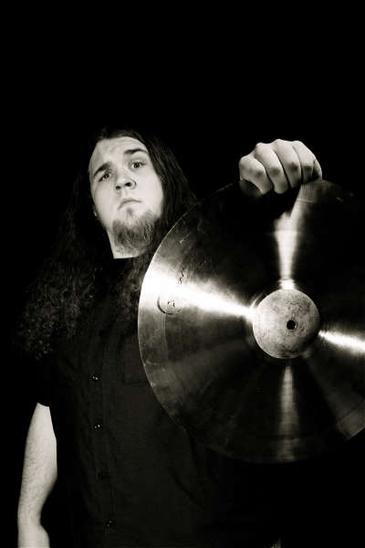
www.deathbymetalstl.com
Interview With Noah Robertson, Drummer Of Motograter!!!
1. How long have you been playing drums?
I have been playing drums for about 20 years now. I started in 6th grade band and stayed in the school music program all the way through High School, where I joined the drumline. It was also during High School that I started my first metal band with some friends. We used to lie about our age so we could play shows at the local clubs and bars! (laughs) After High School, I studied Music Education in College for 3 years and marched in the college drumline as well. I was really distracted from my schoolwork though, performing shows and playing in different bands all the time. I ended up meeting an awesome group of musicians at Tarleton State University in Stephenville, Texas. We eventually dropped out of Music School together and moved to Dallas, looking for more musical opportunities. Eventually, a few of us relocated the band to Hollywood, California. I packed my drums and my clothes in my car and drove to Hollywood by myself... it was a trip. I lived in a rehearsal room, slept on an air mattress, bathed with a bucket of water and a towel, and cooked food on a George Foreman grill! (laughs) My car broke down the very first day I was there so I had to take the bus everywhere, which was awful! I went out there first because I was able to transfer my job. At the time I was working at Guitar Center in Dallas, so I ended up transferring to the Guitar Center on Sunset Strip in Hollywood; the guitar player and bass player moved out there about a month later. A little while later, the band went on hiatus and I began searching for a new project. I answered a Craig's List ad for a new band forming and ended up moving back to Dallas, Texas to start The Browning. The rest is history!
2. Who has greatly influenced you to initially play, and do you think it has integrated into your sound?
I really appreciate these questions, because this is a story I have been wanting to tell for quite some time. I have always loved music, even from an early age. I grew up listening to everything and being influenced by a lot of different styles of music. Around the time I was in middle school I discovered bands like Ugly Kid Joe, Metallica, Iron Maiden, and Megadeth and instantly fell in love with heavy metal. Around High School my love for the genre grew even more. I come from a small, middle-of-nowhere town called Lampasas and there weren't many people at my school that listened to heavy music. The few of us that did, we found each other somehow and became friends. A few of us worked for this sound company called Donner Musik that setup sound systems for private events and weddings and such. One night we setup sound for this band called Un Loco out of Austin, Texas. It blew my mind. It was one of the first metal shows I ever saw and it was the first time I ever got autograph's from a band. That was right around the time I was realizing I wanted to play in a band. You see, up until that point I had only played in the school concert band and the school marching band. My best friend growing up, Brandon Beck, who lived down the street from me, he was a bass player and a singer and he had a band going with some guys. Their drummer ended up quitting and I seized the opportunity. I bought his drum set from him for like $300 dollars. It was this rundown CB-700 kit with a silver wrap. It was completely scratched and dinged up, missing parts, duct taped cymbal stands, broken cymbals. (laughs) I had to mow lawns, wash cars, and do chores around the house to pay it off. I remember walking to his house and paying his mom like 50 bucks a week or something. (laughs) I remember the first song I ever learned on the drum set was "For Whom The Bell Tolls" by Metallica, because we covered it in the band. It was during this time I began discovering bands like Testament, In Flames, Machine Head, and Pantera. I found Pantera's album 'Vulgar Display of Power' on cassette at a local record store, in a bargain bin, for like fifty cents and it didn't leave my stereo for a very long time. I think growing up being exposed to so many different types of music and playing in orchestras and marching in drumline, I just had this intense love for melody and groove. Pantera quickly became my favorite band. In 1998, my buddy Brandon and I borrowed my parents car and drove a few hours to Dallas, Texas to see Pantera perform with Soulfly and Morbid Angel. That concert changed my life forever. It was at that moment that I realized what I wanted to do with my life. I had never been to a big concert like that, and it really had a profound affect on me. It was just these 4 normal looking guys on stage and the crowd went completely out-of-their-minds, insane for them and it was all because of this massive, powerful sound they were creating with their instruments. At the end of the concert Soulfly came out with Pantera and they did this huge, crazy tribal drum jam. My brain exploded. Dimebag Darrell and Vinnie Paul became my idols and I even got a Pantera tattoo on my leg as soon as I turned 18! (laughs) I graduated high school in 2001 and it was right at that time that the "nu metal" explosion was happening. I used to walk up and down the aisles of the local record shop and I would pick albums that had cool artwork. I remember buying the Slipknot, Mushroomhead, and Mudvayne albums just because the front cover appealed to me. The look and sound of those bands immediately grabbed me. Especially Slipknot, Mushroomhead, Sepultura, Soulfly, and Ill Nino because I was a drummer and was in drumline and those bands had awesome auxiliary percussion featured in their songs. These bands were the perfect mix of everything that I loved. Melody and groove with an aggressive edge. I thought it was the coolest thing in the world! (laughs) In 2003, I attended Ozzfest and a band called Motograter took the stage. Something about the dark, tribal groove they emitted and the insane look they had, and the auxiliary drums and crazy Motograter instrument they invented... I became obsessed. I remember buying magazines like Circus and Hit Parader because they had these huge, full color pictures and posters of the band. I used to sit in my room and play along to their songs, trying to emulate Crispy on the drums. It's incredibly surreal to be playing a band that I was such a huge fan of. I remember taking a Motograter poster to a Five Finger Death Punch show in 2006 and having Ivan Moody sign it! (laughs) To get back to your original question, I have definitely taken my musical influences and integrated them into my playing. Without question. My playing is a mixture of every different style, with an emphasis on groove and melody. I love tom toms and have a very tom oriented playing style. I was drawn to the tenor drums in marching drumline because of their "musical" qualities, I tend to be a very melodic drumset player I think. I never want to overplay, I seek to serve the music. To list just a few of my favorite drummers: Vinnie Paul, Igor Cavalera, Josh Freese, Chris "Crispy" Binns, Gavin Harrison, Chris Kontos, Danny Carey, John Tempesta, and about a million other guys. I could name names all day.
3. What was the experience like shifting from a metal band like The Browning, into the industrial style of Motograter?
You know, that is a very interesting question. Both bands are incredibly industrial, by definition, but in very different ways. One of the first things that drew me to the band, The Browning, was the industrial nature of the project. When I first became aware of The Browning, I was living in Hollywood and had just had a project fall apart. I immediately began scouring L.A. and the internet for a new band. I stumbled upon a Craig's List ad that read, "Former As Blood Runs Black Singer Seeks Members For New Project", or something of that nature. It immediately caught my eye because I was aware of ABRB, they were a great band that achieved a decent amount of notoriety in the metal scene. Jonny McBee had been doing this solo project since he was like 16, he called The Browning. Which, by the way... Holy shit, did we ever get so much attention because of the name. What the hell is The Browning? Is it named after the machine gun? Is it named after the famous writer? We would get so many people asking us about the name, especially in interviews. If you go back and watch the interview videos and read the articles, we just started making up random, insane explanations as to what it meant. I'm pretty sure the name came from some weird twist of information... Jonny's school was on Browning street and him and his friend came up with this crazy ghost story or horror movie plot or something... I don't know. Anyways, so Jonny used to program these metal breakdowns on his computer and would throw all these electronic and synth backdrops over it. Then he would scream over it and then Matt Keck would rap over it. When I answered the Craig's List posting, Jonny sent me a link to a Youtube video and I knew I instantly wanted to be in the band. I recognized immediately that this was innovative and unique and I wanted to be a part of it. I always wanted to do something "different" you know? Something special. This was it. Being a metalhead, I was drawn to the aggressiveness and the brutal nature of the music. But it still had this beautiful, intense melody to it. It really grooved too, hard. It was ALL ABOUT groove. I knew it was for me. Up until this point The Browning hadn't actually been a "real band", it was sort of this internet project. Jonny actually had just moved from Missouri to Dallas, Texas to find good musicians to join his band. I answered the call from Hollywood and moved back to Dallas to join the band. Before I did, I talked Brian Cravey, the guitar player from my previous band, Srlsm, that had just pretty much broken up, into joining the band with me. We made a video of us playing along to a demo song from The Browning and sent it to Jonny. He had these other couple guys lined up already, but our video convinced him to go with us. But, yeah, The Browning is definitely a very industrial band, in that it is an "abrasive and aggressive fusion of rock and electronic music". I have always been drawn to bands that have these elements. It's one of the things that eventually drew me to bands like Nine Inch Nails, and Ministry, and American Head Charge, Marilyn Manson, Dope, Mushroomhead, and Motograter. They all have this aggressive element to them, and have this dark edge to them, and have these interesting sounds and samples happening... yet, they somehow are beautiful too. They all have melody. You know, Motograter wasn't always this super melodic entity. That band started with just the Motograter instrument and the Smur Drums. Two guys experimenting with sounds, then they added more members. In the very early days of Moto the band was very tribal and industrial and dark. The guitars were programmed on the first demos. They had all these crazy samples and industrial sounds and tribal drums... and the grinding, low distortion of the Motograter... and these low, guttural growls and screams. It was raw. It was scary. In a good way. Once they added a human on guitar, a little bit of melody began to creep in, I think. And once they got a singer, in addition to a screamer, they sort of evolved into this melodic force. The band became more accessible in a lot of ways, but they managed to retain their dark/industrial side. I think one of the things Motograter is best known for are the creepy industrial sounds and samples, in addition to the great melodies the music has to offer. You could say that The Browning is very industrial, because of the electronics or whatever, but I think some will argue that, as far as, Industrial is also very much about the mood or tone of the music and lyrics. I mean, industrial music is notoriously about politics, and the occult, and just goes to this dark, dark place. Motograter very much has that industrial tone to it. Very dark, very politically driven on that self-titled album. Very "end of the world" type stuff.
4. Do you have a favorite kit or equipment you tend to lean towards?
Oh god, where do I start! (laughs) You know, these questions are very short and concise, but are just busting open cans of worms! (laughs) I am a total drum nerd. I geek out on drum gear, hard. (laughs) I was just at the NAMM Convention and was running around like a kid in a candy store! (laughs) I will start with drums, I suppose. I mentioned that my very first drum set was a run down CB-700 kit. I had a love/hate relationship with that thing... Later, when I got a lot more serious about the drums, my mom helped me get a Tama Rockstar kit. I was in love with Tama Drums because a lot of the drummers I was into were playing them. Vinnie Paul played Tama back in the day and it made me want to play them. I used to have pages of Tama catalogs hung up on my wall in High School. Not naked chicks, but drums. (laughs) I got that Tama Rockstar kit and I just fell in love with it. And it didn't hurt that I wanted so badly to be a Rockstar! (laughs) I have been playing Tama Drums for my entire drumming career. I love Tama more than I can describe. After the Tama Rockstar, I got a Tama Starclassic Performer, which was the best sounding, most beautiful set I had ever heard or seen. Currently I am playing on a Tama Superstar that I have been using for years and years. All the tours I did in The Browning and have done in Motograter were done on this kit, unless of course it was a festival or festival style tour. In which case, I would literally cover the logo of the drums with tape! Now that's loyalty! (laughs) This drum set has been through a lot. I desperately need and want to retire it and get a new set of drums. Hopefully, I can very soon. When I was at NAMM last weekend, I finally met the Tama Artist Relations guy, Aaron, face to face; whom I have been bugging for years. The company was nice enough to offer any of their products to me at artist pricing. I am very grateful for that! I have been using Tama Iron Cobra Double Pedals my entire drumming career as well, and I even recently started using the new Tama Speed Cobra Double Pedals, which are remarkable.
Dream Cymbals is a company I have been with for a very long time, since their early days as a fledgling cymbal company. I was one of their first artists. I found out about them in a product review in a drum magazine. They looked and sounded very interesting and I wanted to try them out. From day one, those guys have been amazing to me. I ordered a few cymbals and instantly fell in love with their products. The cymbals are beautiful, hand crafted masterpieces and they are the most resilient cymbals I have ever played. It took me 6 years to break my 16 inch Energy Series Crash! (laughs) I have an interesting story about Dream... I was especially taken with the high-pitched bell sound that was on the first Motograter record. "Ding!" I was always searching for that sound and how I could re-create it. Years later, I built a relationship with this awesome company, Dream Cymbals. I talked to the President of the company and described to him the bell sound I was trying to achieve. While he was at the factory in China, they put together some prototypes for me and sent them to me to try out. They were perfect! Dream Cymbals now sells them in a few different sizes, they are called Jing Cymbals. Now I play that cymbal in this very band, it's very surreal! (laughs) Seriously, the guys at Dream Cymbals have been outstanding. They have always helped me when I needed them. When I toured Europe, they provided me with a full set of gorgeous Dream Cymbals to use on the tour. They have put my ugly face in places like Drum Magazine and Modern Drummer. (laughs) They are just superb. I mentioned before I attended the NAMM show this past weekend, this big music convention where all the major music manufacturers show off their latest and greatest. I attended the show as a Dream Cymbals artist, and it was amazing to see the Dream guys again and try out all the different cymbals; the last time was at the NAMM Show in 2010. Afterwards, I was invited to a Dream Cymbals after party, where a bunch of Dream Cymbals staff and Dream Cymbals artists had dinner and drinks. It was magical! I love Dream Cymbals and I don't think I could play anything else at this point.
Another company I am extremely fond of is Xcel Drumsticks. The owner Torry is one of the coolest guys ever and he makes truly amazing drumsticks. They have this awesome patented feature they call the "Secondary Striker". It's really great, you should see it! It gives the cymbals, especially the bells a brighter response and helps reduce wear and tear on the drumstick. These sticks last forever. Before playing Xcel Drumsticks, I broke drumsticks all the time, constantly. I can literally get through an entire tour with just a few sets of sticks now. It's amazing. Torry has been great over the years, and he always provides me with what I need, when I need it. I even got a chance to visit the Xcel Drumstick factory recently on a Motograter tour and it was a very cool experience seeing how the drumsticks are made. He made a couple sticks for me, right then and there, it was awesome! I posted a video of my visit on the interwebs, check it out.
The last company I will mention is MEE Audio. A great company. I have been with them for years and they keep getting bigger and better. When I was in The Browning I was desperately searching for a set of In-Ear Monitors that would stay in my ears! I do these crazy hair spins while I'm playing and all the different sets I tried would come out and get tangled up in my hair, it was a nightmare. Finally, I tried the M6 Pro's and they worked like a charm. Not only do they sound great, but they are very comfortable and most importantly they stay put. The guys at MEE are incredibly generous and have always been super accommodating. I finally got to meet those guys at NAMM as well, and they are solid dudes.
5. What motivated you to start up Swimming With Sharks Records? Will you give us some insight on your business and some of the experiences enjoyed over the years?
Well, the first obvious thing is Sharks! (laughs) I have always been obsessed with Sharks, I even have a bunch of Shark tattoos, and it's my stage name too. I always told myself that I would help others and give back as much as possible, whenever I could. I have always held up to that, whenever and wherever I could. It all started my third year of music school, in 2004. I hosted a two hour, live College radio show on KTRL - The Planet. I called it Swimming with Sharks. I produced the entire thing on my own, it was an epic learning experience. I quickly realized that in this small, country town I was the only person broadcasting rock and heavy metal of any sort. I started playing local bands and my friends bands and even played my own bands on the show. I remember putting together my first concerts and getting the local music store to donate a guitar and the local tattoo shop to donate some gift cards and I would advertise the shows on my radio program. Around that same time, I was reading Marilyn Manson's book "The Long Hard Road Out of Hell". In the book he talks about being a music journalist at first and he used the opportunity to write about his own band. It made me think. I used to always email companies and promoters and record labels and nobody ever responded or paid attention. It was a losing battle... I created a company and called it Swimming with Sharks Entertainment. I began promoting bands and booking shows under the name. I began approaching the same companies and booking agents as a representative from this Entertainment Company. Finally they started to respond and take notice. I wasn't just the drummer, trying to get us a show. It was no longer, "Hey guys, it's me the drummer for this band... we are really good." It was now, "Hello, this is Noah from Swimming with Sharks Entertainment. I would like to discuss a very promising act..." Soon I was able to book us all kinds of shows and get us a lot more opportunities. I just kept building my resume and booking us more shows. Over the years, in the bands I have been in, I really don't like to take a back seat. I want to dive in and get involved and really learn the music industry inside and out. I have taken on a million different roles, and have kind of become this jack of all trades. In doing so I have learned a little bit of everything... from web design to graphic design to tour managing to booking to video editor, the list goes on. I wanted to do everything and learn everything. Navigating through the treacherous waters of the music industry has been an eye opening experience. Being on the front lines and trudging through the twisted wasteland that is the music business has been grueling. I have seen the ugly underbelly of the beast. What's that quote from Hunter S. Thompson? He says a bunch of really horrible stuff about the music industry and then he says, "... and there's a negative side too." Or something like that. I know what to do and what not to do, you know? Because I've been there. There are horrible, horrible people out there who are only invested in themselves and they will crush you and leave you in the dirt. I wanted to use all my experiences and knowledge to help bands get to the next step in their careers. I wanted to give back to the music community however I could. When I started signing record deals and negotiating contracts and releasing music and learning about laws and copyrights and loopholes... Well, I learned a lot. I realized I could do everything these companies were doing, granted on a much smaller scale of course, but still I could do it. I had high hopes that I could someday build something great, a community of talented artists and musicians that deserved to be heard. What gave me hope was guys I looked up to like Markus Staiger the founder of Nuclear Blast and Digby Pearson the founder of Earache Records or Brian Slagel who founded Metal Blade. These guys started from nothing, in their apartments and garages. I realized that a label was just that... a name. I started researching and spending hours coming up with this plan and I just went for it. I built a website, and typed up some legal documents, and found some bands and signed them to worldwide digital distribution deals and put out there music, wrote their press releases, everything. One of the cool things we do is we print up a non-exclusive agreement, so that if a bigger opportunity arises for the band, they are not bound to us. We also let the artist retain all of the creative control. We also take as little of a percentage as we can, while still having incentive to want to work for the bands. Although it's been challenging, it's been a lot of fun and we have worked with some truly talented musicians and artists. I could go on and on about this. One of the coolest experiences for me, has been to see it grow from nothing into something I can be proud of. The other day I was searching the internet researching some record labels for my own band, and I came across a list of U.S. Record Labels on Wikipedia and sure enough there was Swimming With Sharks Records. It was just a small, but proud moment. Little things like that, make it all worth while. Seeing our ads in magazines and having fans give us positive feedback on the music we put out, it's very rewarding at times. Also, I have always been a huge fan and collector of metal compilations, in my early metal head days I would go around to different record shops trying to find the latest metal compilations from all the different metal labels so I could discover new bands. I always loved the concept of a good metal compilation. So when I started my own label I put a lot of emphasis on the samplers and compilations. I would print thousands of copies of these things and I would take them on tour with me and pass them out at my shows. It was the perfect opportunity to spread the music around the country. Some of my proudest moments has been playing huge festivals, overseas, to tens of thousand of people and just throwing handfuls of these samplers into the crowd! (laughs) I did that all over Europe and Mexico. It's been awesome. Right now we are really pushing this band from Australia called Eye of the Enemy. They are insanely talented and I feel like this band is really going to be huge someday. They are hardworking and extremely brilliant at what they do. They create this epic, melodic metal for fans of Lamb of God, Pantera, Soilwork, Fear Factory, Killswitch Engage, etc. They currently have two full length albums, or masterpieces I should say, and are working on a third. My dream is to bring them to the states. That would be glorious! I really wish more people knew about them. I am certain they will, in time.
6. What bands or music are you currently listening to?
Great question, I have a funny story about this! (laughs) I write for metal blogs and magazines and such from time to time. I was on tour with Fear Factory and I interviewed Dino Cazares for Hails and Horns Magazine. One of the questions I asked him was this very question, "What have you been listening to lately?" He laughs and says, "Actually, all I've been listening to lately is The Browning, I love it." I just laughed, and blew it off, and said, "No seriously though, I'd really like to know." He gets a serious look on his face and says, "No, seriously bro, I've been jamming your album nonstop." We were on their tour bus and his wife was standing right there and she goes, "No, trust me, he is always listening to The Browning", as she rolls her eyes. Dino, then proceeds to raise his phone, showing me his copy of the 'Burn This World' album. I think my brain melted just a little bit in that moment. It was incredibly surreal. I couldn't believe it. Anyways, back to your question, I think a lot of musicians would try and pick stuff that makes them sound cool, so I'm just going to be completely 100 percent honest here. First of all, I'm a music teacher and I teach private lessons a lot. So, day to day, I end up listening to and playing quite a bit of pop music and classic rock songs. The cool thing is I have the opportunity to influence some of these young minds and introduce them to awesome music. For instance, if a kid comes in, and this happens a lot, and wants to learn a Taylor Swift or Justin Beiber or a Katy Perry song, I will say, "Okay, great we can do that song, but after that can I show you a really awesome band called, Black Sabbath? It's a trade off! (laughs) Honestly, me and the guys in Motograter are quite literally in the middle of recording a new album. So, I've been listening to new Motograter songs take shape over the last few months. Very recently our producer, Ahrue Luster, flew from Colorado to California for about a week and we all sat in a room going over all these songs with a fine-tooth comb. Rehearsing and changing and fixing songs for hours and hours and hours for days on end. Right now we are tracking the album. So, I have been listening to these songs non-stop. Trying to digest what we have created and are creating. I've been listening to the old Moto record too, for inspiration. When I'm just hanging out listening to music... Lately, I have been listening to a lot of Nothingface. I've been jamming the new Sevendust album, which is killer. Eye of the Enemy of course and new Hellbent music. My fiance Audrey and I, we love us some Katatonia and I listen to them often. If you haven't heard of them they are a Swedish band that is very dark and gloomy, yet melodic and beautiful. Love them. We listened to the new Puscifer album the other day. I've been listening to The Bloodline, Ill Nino, and Un Loco quite a bit, because we just toured with both those bands recently. Great bands. I listen to Flaw a lot. Just listened to the new Megadeth and it's killer! I went back and listened to a bunch of Sepultura and Soulfly records recently. Oh, I ran into Max at NAMM! It was unreal! I have been listening to American Head Charge a lot lately, in anticipation of their new album that is about to drop on Napalm Records. I can't wait! It's kind of like when the new Star Wars movie, The Force Awakens, was about to drop and I went back and watched all the old movies to get me in that zone. (laughs) Our producer, Ahrue, is a Star Wars nerd like me. On the way back from picking him up from the airport, we talked about Star Wars quite a bit and we now have this inside joke about the new Moto record... "The Moto Awakens". We all have this goal that we want to achieve with this new record, just like Disney recently achieved with the newest installment of films. We want to give all the old-school fans all of the elements they love and what makes Motograter, Motograter... but we also want it to be modern and accessible to everyone. This new album will have the classic Moto sound that everyone loves, but will have a modern edge to it. I think a lot of people are really going to enjoy this one. We have been working day and night, pouring our blood, sweat, and tears in to this album and it's going to show. We can't wait to unleash this new material. THE MOTO AWAKENS!!!
Interview By Tim McFarland
0 notes
Photo

Latest story from https://movietvtechgeeks.com/paxton-lynch-vs-trevor-siemian-broncos-quarterback/
Paxton Lynch vs Trevor Siemian for Broncos Quarterback
In the competition between quarterbacks Paxton Lynch and Trevor Siemian, the Denver Broncos are talking a good game of being nonpartisan, but it's pretty obvious who they want to win. In 2016, the used their first-round pick on Lynch so their investment has been made, and they want to see some rewards. This offseason's biggest position battle is again in Denver, the quarterback-crazed city where John Elway and Peyton Manning both left the game caked in confetti and continue to cast long shadows. The Broncos, a team with a dazzling defense and ambitions of a deep playoff run, must decide which young quarterback will lead them in 2017: gifted first-rounder Paxton Lynch or egghead seventh-rounder Trevor Siemian. New coach Vance Joseph declared at his introductory news conference he would hold an open QB competition between Siemian, the incumbent, and Lynch, his backup. Either one will be a bargain in the budget-based NFL. Siemian is due $615,000 this season and Lynch $880,000. That's less than a game's work for superstar Von Miller, who will make $17 million in 2017. Yet the team's fortunes rest largely on the winner of this second straight summer quarterback competition. Siemian emerged as Manning's surprise successor last summer, beating out both a raw rookie and an erratic veteran, Mark Sanchez. Siemian proved both impressive and inconsistent. On the one hand, he threw for 3,400 yards and 18 TDs while going 8-6 despite a porous O-line, bland play calling, a battered backfield, and injuries to his left shoulder and right foot. He also had a habit of taking the check-down on third-and-long and not dumping it off in time to avoid big hits. Lynch proved the poster boy for this latest wave of spread quarterbacks who aren't quite as ready for the pros as the wide receivers, defensive backs and edge rushers spawned by college football's latest trend. Bogged down by a complex playbook and fixing his footwork, Lynch went 1-1 in two starts and threw for 500 yards with two TDs and an interception in 10 quarters of work. Neither Siemian nor Lynch did enough to avoid another QB conundrum in Denver, where the question of who's leading the competition reverberates on the radio shows like a daily visit to the optometrist. Is it one or two? On Day 1 of OTAs last week, Siemian was clearly sharper, but he was working with the 1s on the depth chart. On Day 2, when the media weren't allowed to watch, the team's website posted a blurb saying Lynch "showed good decisiveness as the pass rush bore down on him." It added that Lynch "also scrambled for a solid run after he quickly stepped out of pressure from the edge from Von Miller and Shane Ray during a team period late in practice." That was good news for Lynch supporters because Joseph has said the primary factor that will separate the two quarterbacks is making the right lickety-split decisions. Although neither quarterback's 2016 season was enough to avoid another summer of open competition, both see last season's experience as invaluable. "Well, I played. You can't substitute those reps and I learned that pretty quickly," Siemian said. "I think even toward the end of the year ... the game just felt a little easier for me, I saw things a little better." Said Lynch: "The fact that I've had a year to adjust" to the NFL, "and go against our defense for a year is really going to benefit me." After the Broncos finished 9-7 and missed the playoffs for the first time since Elway joined the front office in 2011, Siemian immediately underwent surgery on his left shoulder so he wouldn't miss any of the offseason program. Lynch hurried to work with quarterback fixer Charlie Taaffe to iron out flaws in his footwork. McCOY RETURNS: Elway hired Joseph, and Joseph's first hire was Mike McCoy to run his offense. The Broncos just completed their first week of offense vs. defense drills, and McCoy became the first coach or executive this offseason to describe Lynch's strengths in terms that didn't focus solely on his physical traits. Before, it was always praise for Siemian's acumen and accolades for Lynch's talents. "He's very athletic, and you love his size with his ability to sit in the pocket and see the whole field," McCoy said, speaking excitedly about Lynch. "He's just poised in the pocket and throws those comebacks and out route effortlessly." For the next few weeks, and certainly for a while in training camp, the quarterback competition will be split right down the middle, with each QB working with the starters every other day. "They're rolling with different guys, they're playing with different receivers and different lines all the time," McCoy said. "But they're getting equal reps." FIRST-ROUND STATUS: Even though Siemian showed flashes last season, the Broncos are giving Lynch every chance to win the job a year after Elway moved up five spots to select him with the 26th overall pick. In doing so, he outmaneuvered Jerry Jones, who had his eyes set on Lynch, not Dak Prescott. Prescott would lead the Dallas Cowboys to the NFC's top seed behind the league's best offensive line last season. Lynch never really challenged Siemian last summer when the 250th overall pick in the 2015 draft parlayed his yearlong apprenticeship under Manning and Brock Osweiler into the starting job. Siemian only gave way when he was hurt. Lynch beat Tampa Bay but lost to Atlanta in his two starts. Lynch said he won't get caught up in who he's throwing to or against. "I think every rep is important whether you're with the 1s or you're with the 2s," he said. SHOTGUN WEDDING: Both men love that McCoy's offense features more shotgun snaps than Gary Kubiak's old run-based scheme. "To me, it's pretty different, but I feel like it fits more of how I play, and I'm more comfortable in it," Lynch said. McCoy's system also fits Siemian's skills. "You're five yards back, you catch the ball and can kind of see what's going on," Siemian said. "There are definitely benefits from being under center; the run game, play pass and all those kinds of things. Selfishly though, I think any quarterback you talk to will say they want to be in the gun."
Movie TV Tech Geeks News
0 notes